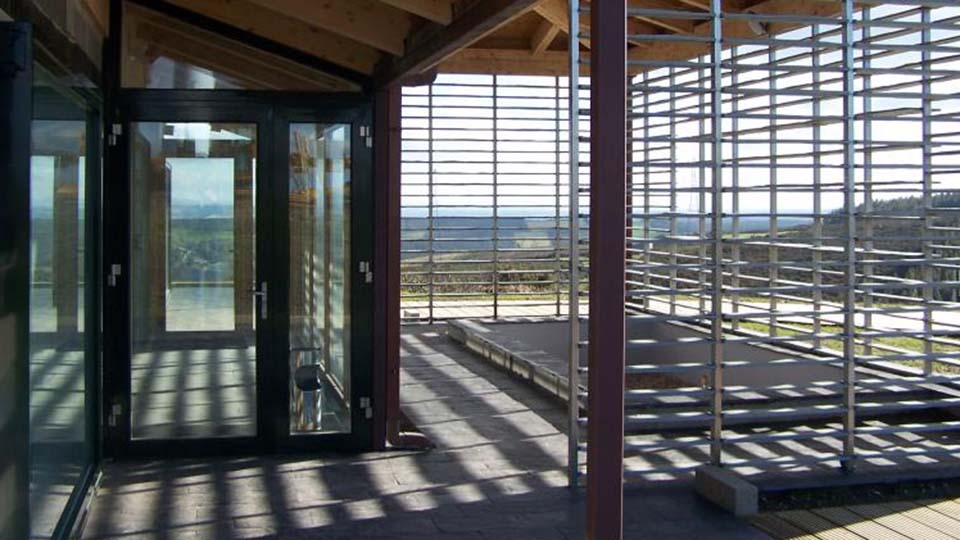BACKGROUND:
The Sotavento Galicia Foundation has at Sotavento Experimental Wind Farm a bioclimatic demonstration house, inaugurated on June 21, 2010. This is a house of 240 m2 constructed under bioclimatic criteria, which have minimized its air conditioning and lighting energy needs, and also includes the use of renewable energy sources.
The main renewable energy facilities housing are:
- A 1.5 kW wind turbine
- Photovoltaic generators of 2.7 kWp installed on the roof of the house in three groups with West, East and South orientations
- Solar thermal generators consisting of 8 sensors of 2.5m2 each, representing approximately 20 kW installed on the south facing roof
- A geothermal heat pump of 8.2 kW with a COP of 4.7 and 500 m. of horizontal geothermal sensors 2 m. average depth
- A pellet biomass boiler of 20 kW
Other important elements related to air conditioning installations are deposits of thermal energy storage (solar and buffer tank) and an evaporative cooler. The property also has a few passive systems such as Trombe walls, galleries, parasols, etc.
In addition to these facilities it is necessary to point out that the house was designed with the purpose of being used for publicity purposes, and above all, as a factor enabling research and development activities related to energy efficiency, renewable energy and bioclimatic architecture. In this sense, the house was installed with sensors and control elements related to their operation. Given the complexity of this system, the number of these elements exceeds 300 units. Among the variables monitored or controlled include:
- Climatic variables (temperature, relative humidity, wind, etc.)
- Temperatures in the various rooms of the house to different levels and relative humidity inside
- Temperature, flow and heat energy in key heating circuits
- Temperature of the ground in the vicinity of geothermal uptake
- Electricity provided by wind and photovoltaic installations and electrical variables related to their operation (voltage, current, etc.)
- Solenoid valve drives, that order the start and stop on installations
OBJECTIVE:
The integration of the acclimatisation systems, the behaviour of the bioclimatic house and renewable energy systems define a complex system which is accessed through the monitoring and introduced control variables. In the house there is implemented some management strategies on site that could be improved to ensure that the house works under the criteria of maximizing energy efficiency and renewable energy use. These are the objectives that the project has been raised:
- Maximizing energy efficiency of housing
- Integration of renewables
PARTICIPATING ENTITIES:
The work described was part of the project “Evaluation of energy efficiency and renewable energy integration in the bioclimatic demo Sotavento Experimental Wind Farm” (2010-2011) funded by the Ministry of Economy and Industry (Government of Galicia) and directed by personnel at the Electrical Energy Department the University of Vigo. In this project, the following entities have collaborated: GOC, S.A., IDI Energy, FAIMEVI, as well as Sotavento, providing the latter with access to all monitored data in the house in addition to its parameters.
METHODOLOGY:
To achieve these objectives it was necessary to address the following phases:
- Analysis of wind resources, solar and geothermal
- Analysis of service facilities and behaviour of house
- Analysis of monitored variables and control variables. This was one of the fundamental phases of the project, because it depended on the achievement of the objectives. It was structured:
- Analysis of consistency of measures and actions, methods of filtering errors
- Proposal to monitor variables and control variables
- Motion control strategies
CURRENT SITUATION:
The project was completed in early 2012. Studies and major conclusions were:
- Compilation of technical information related to the construction and operation of the bioclimatic house
- Energy rating of the house
- Analysis and simulation of the behaviour of the buffer storage
- Analysis of the geothermal installation operation
- Development of analysis tools for the house monitoring data
- Development of state estimation tools for wind and PV systems
- Analysis of photovoltaic generation (obtaining the V-I curve and performance analysis)


